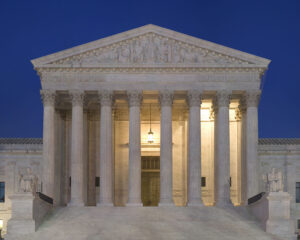In 2007, the U.S. Supreme Court declared greenhouse gases to be pollutants subject to regulation under the Clean Air Act. The Court’s decision in Massachusetts v. EPA triggered a series of far-reaching regulatory proposals from the Environmental Protection Agency designed to control greenhouse gas emissions from motor vehicles, utilities, and other sources. But this was not the end of climate litigation.
A series of lawsuits filed by state attorneys general, environmentalist groups, and plaintiffs’ lawyers have called upon federal courts to declare global warming a “public nuisance” and impose judicially devised emission controls. In these cases, federal judges have struggled with jurisdictional and procedural questions as they have considered how to apply the common law of nuisance to global climate change. One of these cases, American Electric Power v. Connecticut, has made its way up to the Supreme Court and will be argued this spring. This case has potentially broad implications for climate change litigation and policy.
The American Electric Power case began when several northeastern states and a handful of environmentalist groups sued several of the nation’s largest utilities, alleging their emissions of greenhouse gases, largely from coal-fired power plants, constituted actionable contributions to the “public nuisance” of global warming. Instead of monetary damages, the enterprising attorneys general, who spearheaded this litigation, sought court-ordered emission controls. The utilities responded with the argument that federal courts lack jurisdiction to consider questions related to global climate change. As a global problem, climate change is a “generalized grievance” that affects everyone, the defendants argued, and should therefore be left to the political process. The district court agreed. The U.S. Court of Appeals for the Second Circuit did not. Now it is the Supreme Court’s turn.
This case raises several questions which could determine whether federal courts will continue to hear cases raising nuisance claims against emitters of greenhouse gases. Among other things, the Court will consider whether states and environmentalist groups have standing to bring such claims. The Court narrowly concluded that states had standing to sue the EPA over its failure to regulate greenhouse gases in Massachusetts v. EPA, but that does not mean Connecticut and other states have standing. In Massachusetts, the Court found reasons to grant states “special solicitude” under the Clean Air Act, but these reasons are not applicable here. Specifically, the Court stressed that Massachusetts was seeking to protect a procedural right to challenge EPA action as guaranteed by the Clean Air Act. Connecticut, on the other hand, is simply filing a common law claim.
Although the Obama Administration has moved to impose regulations on greenhouse gas emissions, it has also encouraged the Court to accept this case and curtail climate change nuisance litigation. The Solicitor General’s office filed a brief with the Court suggesting both that the plaintiffs lack standing and that the promulgation of greenhouse gas regulations by EPA should preclude this suit.
Whether or not the predicted effects of global warming could constitute a public nuisance under common law, the claim is that federal regulation is sufficiently pervasive to displace traditional common law remedies in federal court. This is not a new argument. Federal regulation of water pollution precluded downstream states from pursuing nuisance claims against upstream states—often with significant environmental consequences. By the same token, the Justice Department suggested, if regulators are addressing climate change concerns with new regulatory measures, there is no room for nuisance-based claims in federal court. Given the Court’s Massachusetts holding that the Clean Air Act covers greenhouse gases, it is indisputable that Congress has occupied the field with a comprehensive regulatory scheme, so the same logic that controlled the water pollution cases would seem to apply here.
The Court is unlikely to reconsider any of its Massachusetts v. EPA findings, but the decision in American Electric Power could have far-reaching implications nonetheless. A narrow decision could bring much climate-based litigation to a halt, while a broad affirmance of the Second Circuit’s reasoning could unleash a torrent of new legal claims. A split decision—a real possibility because Justice Sonia Sotomayor is recused—would foster continued uncertainty on whether courts are the proper place to answer questions of climate change policy. We should have an answer later this spring.




